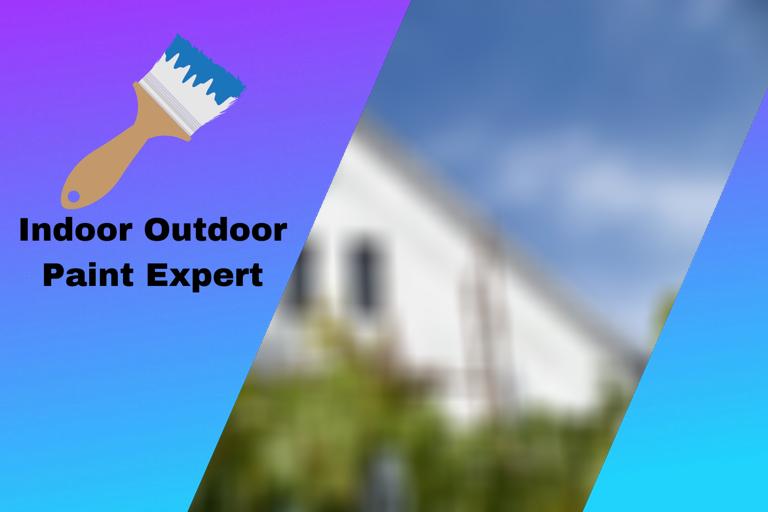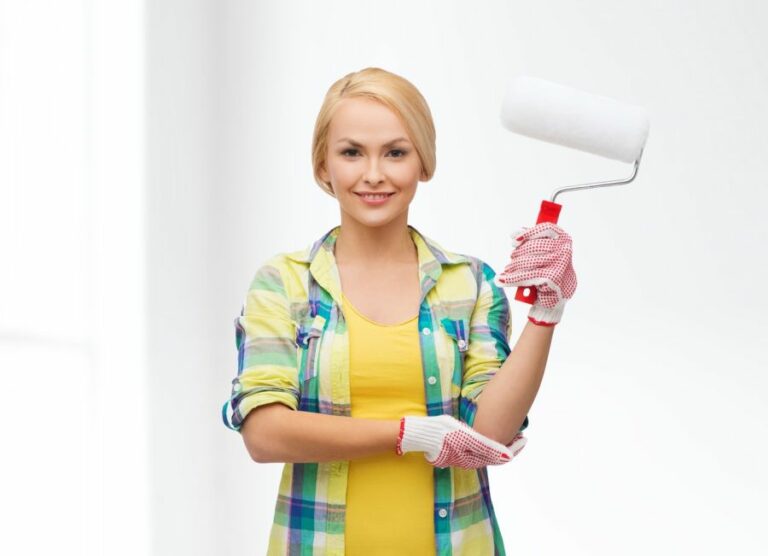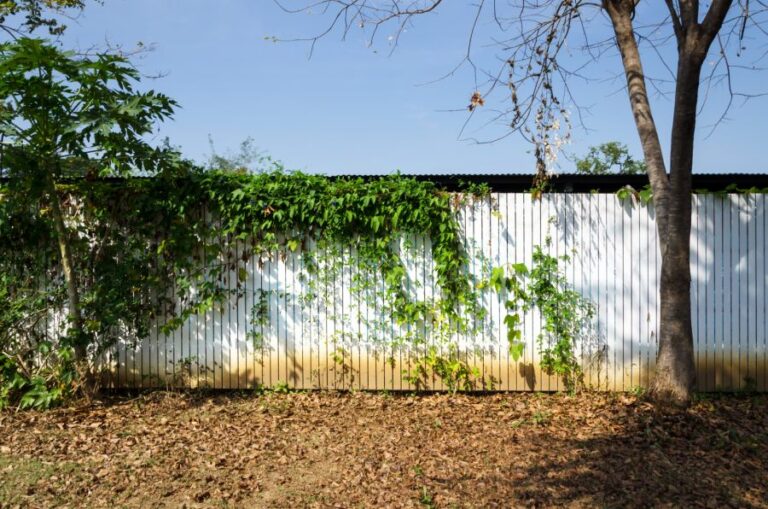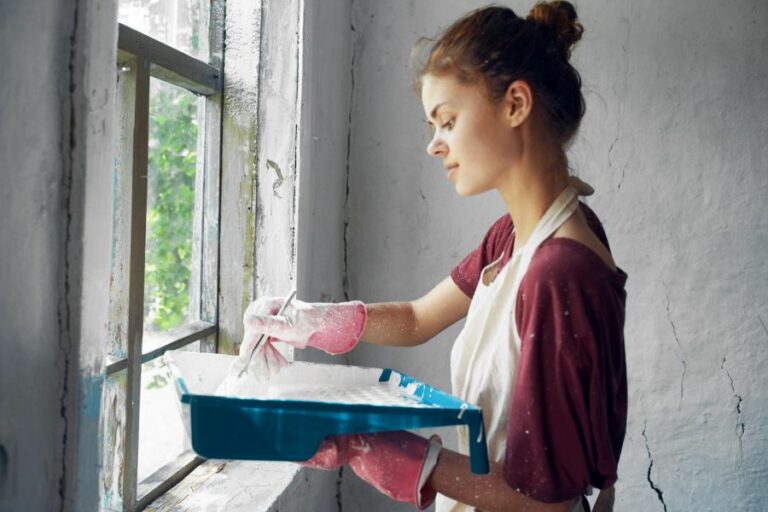White Outdoor Paint For Wood, 25 Things You Should Know
Are you tired of dull and worn-out wooden surfaces in your outdoor space? It’s time for a transformation! Explore the benefits of using white paint, including its protective properties and timeless appeal. Learn about the best paint options and tips for achieving flawless results. Elevate the aesthetics of your garden furniture, fences, and sheds with the simple elegance of white paint.
White outdoor paint for wood:
White outdoor paint enhances and protects exterior wooden surfaces from moisture, insects, and rot. Important factors when selecting white outdoor paint for wood include durability, water resistance, UV resistance, and ease of application. The paints are oil-based, water-based (latex), high-gloss, and satin or semi-gloss. To achieve a professional-looking finish, ensure proper surface preparation, priming, and paint application. Maintain the paint by regularly cleaning and inspecting the surfaces, addressing issues promptly for lasting beauty and protection.

Discover the transformative power of white outdoor paint for wood! Learn about top-rated products, professional application tips, and essential maintenance advice. Elevate your exteriors with timeless beauty and lasting protection. Read on to give your wooden surfaces a refreshing makeover.
Contents
- 1 Premium Exterior White Paint for Wood Surfaces
- 2 What is the Optimal Paint Choice for Exterior Wooden Surfaces?
- 3 Which Type of White Paint is Suitable for Use on Wooden Surfaces?
- 4 Which Type of White Paint is Suitable for Residential Exterior Use?
- 5 Identifying the Optimal Exterior Paint for Wooden Surfaces Exposed to Direct Sunlight
Premium Exterior White Paint for Wood Surfaces
• Why Choose White Outdoor Paint for Wood
White outdoor paint not only adds a touch of elegance and purity to exterior wooden surfaces, but also serves as a protective barrier against elements like moisture, insects, and rot.
• Factors to Consider When Selecting White Outdoor Paint for Wood
– Durability
Durability is crucial when choosing outdoor paint, as it must endure the effects of the weather, sunlight, and other environmental factors. Go for a paint that resists fading, chipping, and cracking and offers long-lasting protection.
– Water Resistance
Wooden surfaces exposed to moisture can lead to swelling, warping, or rotting. Therefore, opt for a paint that offers water resistance, forming a protective barrier that helps prevent water damage.
– UV Resistance
Exposure to harsh UV rays can cause paint to fade, crack, or break down over time. Select a paint with UV-resistant properties to maintain the color and finish of your painted wooden surfaces.
– Ease of Application
Applying paint can be a labor-intensive task, so choose a paint that is easy to apply, with minimal preparation, and dries quickly.
• Types of White Outdoor Paint for Wood
– Oil-Based Paints
Oil-based paints are known for their durability, water resistance, and smooth finish. They take longer to dry compared to water-based paints, but that slower drying time allows for better leveling and fewer brush marks.
However, oil-based paints emit strong fumes and can be more challenging to clean (turpentine or paint thinner is required). Always follow manufacturer recommendations and safety precautions when working with oil-based paints.
– Water-Based (Latex) Paints
Water-based paints, also known as latex paints, are easy to apply, clean up with soap and water, and emit fewer fumes. They dry quickly and offer good durability but may not adhere as effectively as oil-based paints, especially on previously painted surfaces.
Latex paint is flexible, resists cracking, and allows moisture to escape, which benefits exterior wood surfaces.
– High-Gloss Paints
High-gloss paints provide a shiny, reflective finish and are ideal for highlighting architectural details or creating a statement with bold contrasts. They are also durable and easy to clean, making them suitable for high-traffic areas.
– Satin or Semi-Gloss Paints
Satin or semi-gloss paints deliver a balance of durability, easy cleaning, and a subtle sheen. They can be used on a variety of exterior wood surfaces, providing a smooth, elegant finish.
• Tips for Applying White Outdoor Paint on Wood
– Proper Surface Preparation
Preparing the wood surface before painting is crucial to achieving a professional-looking, durable finish. Start by cleaning the wood to remove dirt, dust, and mildew. If necessary, use a pressure washer or a specialized wood cleaner. Allow the wood to dry completely before proceeding.
Remove any loose, peeling, or flaking paint with a scraper, wire brush, or sandpaper for previously painted surfaces. Sand the wood surface to smooth out any rough spots and ensure proper adhesion of the new paint.
– Priming
Priming helps create a uniform surface for paint application and improves adhesion, preventing issues like peeling and blistering. Use a high-quality primer designed for exterior wood surfaces, and allow it to dry according to the manufacturer’s instructions.
– Paint Application
Use a high-quality brush, roller, or sprayer when applying the paint. Work in manageable sections, maintaining a wet edge to avoid lap marks. Apply at least two coats of paint, allowing each coat to dry thoroughly before applying the next.
• Maintaining White Outdoor Paint for Wood
Inspect your painted wood surfaces every few months for signs of wear or damage. Regularly clean painted wood with a soft brush or cloth and mild soap, then rinse with water. Avoid using abrasive cleaners or harsh chemicals, as they may damage the paint.
If you notice any chipping, peeling, or fading, address the issue promptly to prevent further damage. Lightly sand the affected area, prime if necessary, and apply a fresh coat of paint.
By considering the factors outlined in this ultimate guide and following the recommended tips for application and maintenance, you’ll be well-equipped to select and apply the best white outdoor paint for your wooden surfaces, ensuring lasting beauty and protection.
What is the Optimal Paint Choice for Exterior Wooden Surfaces?
A well-painted exterior wooden surface enhances the aesthetic appeal of your property and protects it from harsh weather conditions and potential damage. Choosing the right paint for your outside wood is, therefore, essential.
• Characteristics of the Best Paint for Exterior Wood
The best paint for exterior wood surfaces shares some common traits, which include:
– Durability
High-quality exterior paint should be able to withstand harsh weather conditions, such as direct sunlight, heavy rain, snow, and strong winds. This paint should retain its color and protective properties for several years.
– Moisture Resistance
Protecting your outside wood from moisture is critical in preventing mold, mildew, and rot. Quality exterior paint should have excellent water-repellent properties and should dry quickly to avoid water absorption.
– UV Resistance
Prolonged exposure to ultraviolet (UV) rays can cause fading and peeling of paint. The best paint for exterior wood surfaces should have excellent UV resistance, ensuring that the color remains vibrant over the years.
– Ease of Application
The ideal paint should be easy to apply and provide complete coverage in just one or two coats. This saves you time and reduces the overall cost of the painting job.
• Types of Paint for Exterior Wood
There are mainly three types of paint suitable for exterior wood surfaces. They include:
1. Water-Based Acrylic Paints
Due to their numerous benefits, water-based acrylic paints are the most popular and widely recommended paint for exterior wood surfaces. These paints are easy to apply and clean up, as they only require water for dilution and cleaning.
They also have low Volatile Organic Compounds (VOCs), making them environmentally friendly and safe for use.
- Pros
- Non-toxic
- Fast drying
- Easy to clean
- Resistant to cracking and peeling
- Low VOC emissions
- Cons
- May not adhere to certain surfaces
- Can be less durable than oil-based paints
2. Oil-Based (Alkyd) Paints
Oil-based paints were traditionally used on exterior wood surfaces due to their durability and resistance to weathering. However, they have become less popular in recent years, primarily because of their high VOC content and the need for harsh chemicals, such as mineral spirits, during clean-up.
Pros:
- Durable
- High UV resistance
- Retains color better than water-based paints
- Adheres to a wide range of surfaces
Cons:
- Slow drying
- High VOC emissions
- Difficult to clean afterwards
- Can become brittle over time
3. Specialty Paints
Specialty paints are formulated to address specific needs, such as mold and mildew resistance, enhanced UV protection, or added texture. Some examples of specialty exterior wood paints include elastomeric, anti-slip, and high-heat paint.
Pros:
- Tailored to specific requirements
- Offer additional protection
Cons:
- Potentially high costs
- Limited color options
• Tips for Choosing the Best Paint for Exterior Wood
Here are some expert recommendations to consider when selecting the right paint for your outside wood surfaces:
– Compatibility
Ensure that the paint you choose is compatible with the type of wood and existing paint or stain on your exterior surfaces. Always conduct a test patch before applying the paint to a larger area.
– Environmental Impact
Choose paint with low VOC content if you’re concerned about the environmental impact of your painting project. Water-based acrylic paints are an excellent choice as they have lower VOC emissions than oil-based alkyd paints.
– Color Retention
Select a paint that has excellent color retention properties to ensure that your exterior wood surfaces maintain their vibrant appearance over time. Acrylic paints are known for their color durability, while oil-based paints can also provide long-lasting color protection.
– Primer
Using a high-quality primer before applying a topcoat of paint will ensure better adhesion and longevity of the paint job. Priming also helps to seal the wood, preventing moisture and other environmental contaminants from penetrating through the paint, which can cause premature paint failure.
• Final Thoughts
While there is no “one-size-fits-all” answer to the best paint for outside wood, water-based acrylic paints are generally recommended for their ease of use, environmental friendliness, and durability.
Take into consideration your specific needs, budget, and preferences when selecting the right paint for your exterior wood surfaces. Proper surface preparation, such as cleaning and priming the wood, is also essential for ensuring a successful paint job that will provide protection and beauty for years to come.
Paint Type | Description | Advantages | Disadvantages |
|---|---|---|---|
Latex | Water-based paint made from synthetic polymers | Easy to clean, dries quickly, low odor, resistant to peeling and cracking | Not as durable as oil-based paint |
Oil-based | Alkyd paint that dries harder than latex | Durable, resistant to wear and tear, longer-lasting finish | Slower drying time, harsh odor, requires mineral spirits for clean-up |
Acrylic latex | Hybrid paint combining acrylic and latex properties | Adheres well to wood, excellent durability, flexible and less prone to cracking, easy to clean | Can be more expensive than other options |
Solid-color stain | A penetrating, heavier-bodied stain that provides a solid layer of color | Protects wood from UV rays and weather, shows wood texture, easy to apply | May require more frequent recoating than paint, less color options |
Which Type of White Paint is Suitable for Use on Wooden Surfaces?
While selecting paint for different surfaces, it is essential to understand the type of paint needed for each specific need, especially when it comes to wood.
– Acrylic Paint
Acrylic paint is a popular choice for painting wood surfaces. This water-based paint is durable and provides excellent adhesion to various surfaces, including wood. Some of its advantages include:
- Quick-drying time
- Easy to clean up with water
- Low odor
- Resistant to cracking and fading
I recommend using acrylic paint for projects such as wooden furniture and trims because it provides a durable finish that resists yellowing over time. Additionally, acrylic paint can be utilized for both interior and exterior wooden surfaces.
When selecting acrylic paint for wood, look for paints specifically formulated for wood surfaces, as these generally have better adhesion and durability.
– Latex Paint
Latex paint is another water-based paint option suitable for use on wood surfaces. It is a versatile paint choice that offers several benefits, such as:
- High resistance to scrubbing and staining
- Low VOCs (Volatile Organic Compounds)
- Easy application and cleanup
- Quick drying time
It is important to mention that latex paint is an excellent choice for both interior and exterior wood surfaces, such as wood sidings, doors, and even cabinets.
For exterior wood applications, particularly in areas exposed to harsh weather conditions, consider using high-quality, durable latex paint to ensure the surface remains well protected.
– Oil-Based Paint
Oil-based paint, also known as alkyd paint, is a traditional choice for wood surfaces. It offers a durable and smooth finish and provides excellent adhesion. Here are some key reasons to choose oil-based paint for wood:
- Long-lasting finish
- More coverage per coat
- Superior leveling capabilities
- Great for high-traffic areas
However, oil-based paint has some drawbacks. It has a stronger odor, takes longer to dry, and requires mineral spirits or paint thinner for cleanup. Additionally, oil-based paint tends to yellow over time, particularly when exposed to sunlight.
Due to these concerns, weighing the pros and cons before deciding on oil-based paint for wood surfaces is essential.
– Milk Paint
Milk paint is an eco-friendly option for wood, made from mineral pigments, casein (a milk protein), and lime. It provides a natural, matte finish and is ideal for those looking for an environmentally friendly option. Key benefits of milk paint include:
- No VOCs and low odor
- Environmentally safe
- Non-toxic
- Provides a unique antique look
Milk paint is an excellent choice for painting wooden furniture or other projects where you want to achieve a distressed or vintage finish. Remember that milk paint requires proper surface preparation, such as sanding and applying a bonding agent, to ensure proper adhesion to the wood surface.
– Chalk Paint
Chalk paint is a popular option for DIY enthusiasts who appreciate its ease of use and unique finish. It is specifically formulated to adhere to wood without the need for extensive surface preparation. Other notable features of chalk paint are:
- Smooth, matte finish
- Easily distressed for a vintage look
- Requires little to no surface preparation
- Dries quickly
Chalk paint is an ideal option for wooden furniture, particularly if you’re looking to create a shabby chic, or vintage look. While it can be used for both interior and exterior applications, it is primarily recommended for interior wood surfaces.
– Enamel Paint
Enamel paint provides a hard, durable finish suitable for wood surfaces exposed to high levels of wear and tear, such as wooden door frames, trim, and furniture. Some key advantages of enamel paint include the following:
- High-gloss finish
- Excellent durability and abrasion resistance
- Effective protection against moisture and stains
Enamel paints can be either oil-based or water-based. While oil-based enamel paints are more durable and have superior leveling properties, water-based enamel paints dry more quickly and emit fewer VOCs.
Whether you choose oil-based or water-based enamel paint, using a high-quality brush or roller is essential to achieve a smooth, professional finish.
• Final Thoughts
In conclusion, while several types of white paint are suitable for wood surfaces, it’s essential to consider the intended application, surface condition, and desired finish when making your decision.
Always remember to thoroughly prepare the wood surface and use the appropriate tools and techniques for each paint type. With careful planning and execution, you can achieve beautiful, long-lasting results on your wood projects.
Which Type of White Paint is Suitable for Residential Exterior Use?
Choosing the right white paint for the exterior of your house is a crucial decision that should not be taken lightly. With an array of available options, picking the perfect shade and type of paint can feel overwhelming.
• Understanding the Types of Exterior White Paints
The exterior white paints primarily fall under latex, alkyd, and elastomeric categories. Each type comes with its own set of benefits that make it suitable for specific surfaces and conditions.
– Latex Paints
Latex paints, also known as water-based paints, are popular for house exteriors due to their durability, ease of application, and quick drying time. They are also resistant to fading, yellowing, and chalking.
However, it is important to note that latex paints do not adhere well to surfaces previously painted with oil-based paint.
Recommended Product: Behr Premium Plus Ultra Exterior Paint and Primer in One
This paint has an excellent balance of quality and value. Its advanced adhesive technology ensures optimal adhesion even on previously painted surfaces. Moreover, it shields your home against harsh weather conditions, maintaining its fresh appearance for longer.
– Alkyd Paints
Alkyd, or oil-based paints, are known for their exceptional adhesion properties and are particularly suitable for surfaces prone to chalking, such as wood, metal, or previously painted exteriors.
However, they take longer to dry and may require a more orchestrated approach during application. Furthermore, they tend to emit strong odors and are not environmentally friendly.
Recommended Product: Benjamin Moore Aura Exterior Paint
Aura offers excellent durability and color retention properties. Its advanced alkyd technology allows for a smooth application and finish. Additionally, it has mildew-resistant properties that help preserve the paint’s pristine appearance.
– Elastomeric Paints
Elastomeric paints are specifically designed for surfaces with hairline cracks or those prone to expanding and contracting due to changing temperatures. They form a flexible, waterproof layer that bridges minor cracks and prevents further damage.
However, they are not suitable for wood surfaces and tend to be more expensive than other types of paint.
Recommended Product: Sherwin-Williams Conflex XL Elastomeric Coating
Conflex XL provides excellent coverage and superior durability while remaining flexible enough to accommodate surface movement. Its waterproof properties protect your home from moisture damage, making it an ideal choice for masonry or stucco surfaces.
• Factors to Consider When Choosing Exterior White Paint
Several factors can influence the choice of white paint for your house’s exterior. Keep the following considerations in mind before making a decision:
– Surface Material
Different types of white paint adhere better to specific surfaces. It is essential to choose a paint designed for your exterior’s surface material.
- Latex paint: Ideal for most surfaces, including brick, stucco, and fiber cement siding
- Alkyd paint: Suitable for wood, metal, or previously painted exteriors
- Elastomeric paint: Best for masonry or stucco surfaces with minor cracks
– Climate Conditions
The weather conditions in your region can significantly impact the durability and appearance of your exterior paint. Choose a specifically formulated paint to withstand the demands of your local climate.
- Hot and sunny areas: Look for paint with UV resistance to prevent fading
- Humid and wet regions: Opt for paint with mildew and mold-resistant properties
- Cold climates: Choose a paint with good adhesion properties to prevent flaking
– Finish
Exterior white paint is available in various finishes, such as flat, satin, semi-gloss, and gloss. The finish you choose will not only affect the appearance of your house but also its durability.
- Flat finish: Provides a soft, matte look but may be less resistant to dirt and stains
- Satin and semi-gloss finishes: Offer a balance between durability and aesthetics, making them ideal for most exteriors
- Gloss finish: Delivers a shiny look and provides excellent resistance to dirt and stains but may highlight surface imperfections
• Conclusion
Selecting the right white paint for your house exterior is crucial for the longevity and beauty of your home. Explore the various types of white paints available and consider factors such as surface material, climate conditions, and finish to make an informed choice.
Investing in high-quality paint uniquely tailored to your house’s needs ensures a flawless and lasting finish that will boost your home’s curb appeal for years to come.
Identifying the Optimal Exterior Paint for Wooden Surfaces Exposed to Direct Sunlight
Outdoor wooden structures, such as fences, decks, and furniture, can be a beautiful addition to your garden or patio. However, they also require protection from the harsh effects of direct sunlight.
Over time, exposure to the sun’s ultraviolet (UV) rays can cause wood to degrade, fade, crack, and become susceptible to moisture damage. Choosing the right paint for your outdoor wood is crucial in providing protection against these negative effects.
• Identifying the Key Attributes of High-Quality Outdoor Wood Paint
When searching for the best paint for your outdoor wood, consider the following attributes that contribute to the paint’s durability and resistance to sun damage:
- UV Resistance: A paint that can effectively block UV rays will help prevent the wood from becoming discolored, weathered, and weak.
- Moisture Resistance: Outdoor wood is exposed to changing weather conditions, including rain, snow, and humidity. A paint that can withstand moisture will prevent swelling, rot, and mold growth.
- Flexibility: The paint should be able to expand and contract along with the wood in response to temperature fluctuations to avoid cracking or peeling.
- Longevity: High-quality paint should last for several years without needing a touch-up or re-coating.
- Ease of Application: The paint should be easy to apply, dry quickly, and offer a smooth finish with minimal brush strokes.
Considering these qualities will help you identify the best paint for your outdoor wood in direct sunlight.
• Acrylic Latex Paint: A Top Choice for Outdoor Wood
While many types of paint are available, acrylic latex paint stands out as an excellent choice for exterior wood in direct sunlight.
This water-based paint is known for its durability, UV resistance, and moisture resistance. It also provides a flexible and breathable finish that allows the wood to expand and contract without causing the paint to crack or peel.
In addition, acrylic latex paint dries quickly and is easy to clean with soap and water. This makes it an attractive option for DIY enthusiasts and professional painters alike.
– My Top Acrylic Latex Paint Recommendations
I’ve personally experienced success with several acrylic latex paints that provide excellent protection for outdoor wood in direct sunlight. Here are my top three recommendations:
- Behr Premium Plus Exterior Paint & Primer in One: This self-priming paint offers unsurpassed durability and excellent adhesion, ensuring your wood stays protected in harsh sunlight. The paint also boasts a mildew-resistant finish and a 100% acrylic formula, providing a flexible and breathable coat.
- Valspar Duramax Exterior Paint: This water-based paint is designed specifically for extreme weather conditions, including direct sunlight. It’s resistant to cracking and fading, ensuring your wood stays vibrant and protected throughout the years. Furthermore, the product promises a 100% acrylic formula that is meant to outlast some of the toughest weather conditions.
- Sherwin-Williams Emerald Exterior Acrylic Latex Paint: This premium paint provides exceptional UV protection and resists blistering, peeling, and chalking, ensuring the longevity of your paint project. The advanced acrylic formula ensures the paint remains flexible, accommodating the natural movement of the wood.
• Tips for Preparing and Painting Outdoor Wood
- Thoroughly clean the wood: Before applying paint, it’s important to ensure that the wood is clean, free from dirt and mildew, and as dry as possible. Use a suitable cleaning solution and a soft-bristle brush to remove any debris, then allow the wood to dry completely.
- Sand and prime: Sand the wood surface to remove any old paint, stains, or loose fibers and to create an even, smooth surface to the paint to adhere to. A quality primer will help the paint adhere better to the wood, creating a more durable and protective finish.
- Choose the right tools: Using a high-quality brush or roller designed for exterior use will result in a smoother, more professional finish. If you’re using a paint sprayer, make sure it’s compatible with your chosen paint.
- Apply at least two coats: Two or more coats of paint will provide better protection against direct sunlight and weather conditions. Be sure to allow each coat to dry fully before applying the next.
- Paint on a dry, calm day: Choose a day when the weather is calm and dry to paint your outdoor wood. This will ensure that the paint dries evenly and is less likely to be affected by dust, wind, or rain.
By following these tips and choosing high-quality acrylic latex paint, your outdoor wood will be well-protected against the harmful effects of direct sunlight, ensuring a longer-lasting and more beautiful finish.
Brand | Product Name | Key Features |
|---|---|---|
Behr | Behr Premium Plus Ultra Exterior | UV-resistant, long-lasting, mildew-resistant finish |
Benjamin Moore | Aura Exterior | Color Lock technology, fade resistant, excellent durability |
Sherwin-Williams | Emerald Exterior Acrylic Latex Paint | Self-priming, UV resistant, durable & long-lasting |
Valspar | Reserve Exterior | A fade-resistant finish, flexible to resist cracking |
Rust-Oleum | Total Defense Exterior | UV & weather-resistant, long-lasting, mold & algae resistant |







